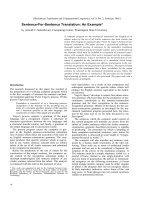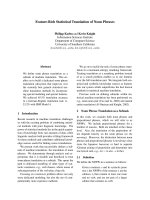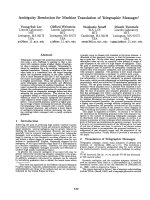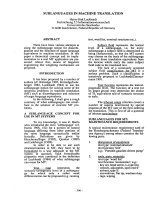Báo cáo khoa học: "Expanding Indonesian-Japanese Small Translation Dictionary Using a Pivot Language" pot
Bạn đang xem bản rút gọn của tài liệu. Xem và tải ngay bản đầy đủ của tài liệu tại đây (560.13 KB, 4 trang )
Proceedings of the ACL 2007 Demo and Poster Sessions, pages 197–200,
Prague, June 2007.
c
2007 Association for Computational Linguistics
Expanding Indonesian-Japanese Small Translation Dictionary
Using a Pivot Language
Masatoshi Tsuchiya
†
Ayu Purwarianti
‡
Toshiyuki Wakita
‡
Seiichi Nakagawa
‡
†
Information and Media Center /
‡
Department of Information and Computer Sciences,
Toyohashi University of Technology
, {wakita,ayu,nakagawa}@slp.ics.tut.ac.jp
Abstract
We propose a novel method to expand a
small existing translation dictionary to a
large translation dictionary using a pivot lan-
guage. Our method depends on the assump-
tion that it is possible to find a pivot lan-
guage for a given language pair on con-
dition that there are both a large transla-
tion dictionary from the source language
to the pivot language, and a large transla-
tion dictionary from the pivot language to
the destination language. Experiments that
expands the Indonesian-Japanese dictionary
using the English language as a pivot lan-
guage shows that the proposed method can
improve performance of a real CLIR system.
1 Introduction
Rich cross lingual resources including large trans-
lation dictionaries are necessary in order to realize
working cross-lingual NLP applications. However,
it is infeasible to build such resources for all lan-
guage pairs, because there are many languages in the
world. Actually, while rich resources are available
for several popular language pairs like the English
language and the Japanese language, poor resources
are only available for rest unfamiliar language pairs.
In order to resolve this situation, automatic con-
struction of translation dictionary is effective, but it
is quite difficult as widely known. We, therefore,
concentrate on the task of expanding a small existing
translation dictionary instead of it. Let us consider
three dictionaries: a small seed dictionary which
consists of headwords in the source language and
their translations in the destination language, a large
source-pivot dictionary which consistsof headwords
in the source language and their translations in the
pivot language, and a large pivot-destination dictio-
nary which consists of headwords in the pivot lan-
guage and their translations in the destination lan-
guage. When these three dictionaries are given, ex-
panding the seed dictionary is to translate words in
the source language that meets two conditions: (1)
they are not contained in the seed dictionary, and (2)
they can be translated to the destination language
transitively referring both the source-pivot dictio-
nary and the pivot-destination dictionary.
Obviously, this task depends on two assumptions:
(a) the existence of the small seed dictionary, and
(b) the existence of the pivot language which meets
the condition that there are both a large source-
pivot dictionary and a large pivot-destination dic-
tionary. Because of the first assumption, it is true
that this task cannot be applied to a brand-new lan-
guage pair. However, the number of such brand-
new language pairs are decreasing while machine-
readable language resources are increasing. More-
over, The second assumption is valid for many lan-
guage pairs, when supposing the English language
as a pivot. From these point of view, we think that
the expansion task is more promising, although it de-
pends more assumptions than the construction task.
There are two different points among the expan-
sion task and the construction task. Previous re-
searches of the construction task can be classified
into two groups. The first group consists of re-
searches to construct a new translation dictionary for
a fresh language pair from existing translation dic-
tionaries or other language resources (Tanaka and
Umemura, 1994). In the first group, information of
the seed dictionary are not counted in them unlike
the expansion task, because it is assumed that there
is no seed dictionary for such fresh language pairs.
The second group consists of researches to translate
197
x
s
v(x
s
) v
t
(x
s
)
y
s
z
s
u(z
s
)
Corpus in
the source
Source-Pivot
Dictionary
Pivot-
Destination
Dictionary
Corpus in
the destination
Seed
Dictionary
Select
output
words
Figure 1: Translation Procedure
novel words using both a large existing translation
dictionary and other linguistic resources like huge
parallel corpora (Tonoike et al., 2005). Because al-
most of novel words are nouns, these researches fo-
cus into the task of translating nouns. In the expan-
sion task, however, it is necessary to translate verbs
and adjectives as well as nouns, because a seed dic-
tionary will be so small that only basic words will be
contained in it if the target language pair is unfamil-
iar. We will discuss about this topic in Section 3.2.
The remainder of this paper is organised as fol-
lows: Section 2 describes the method to expand a
small seed dictionary. The experiments presented in
Section 3 shows that the proposed method can im-
prove performance of a real CLIR system. This pa-
per ends with concluding remarks in Section 4.
2 Method of Expanding Seed Dictionary
The proposed method roughly consists of two steps
shown in Figure 1. The first step is to generate a co-
occurrence vector on the destination language cor-
responding to an input word, using both the seed
dictionary and a monolingual corpus in the source
language. The second step is to list translation can-
didates up, referring both the source-pivot dictionary
and the pivot-destination dictionary, and to calculate
their co-occurrence vectors based on a monolingual
corpus in the destination.
The seed dictionary is used to convert a co-
occurrence vector in the source language into a
vector in the destination language. In this paper,
f(w
i
, w
j
) represents a co-occurrence frequency of
a word w
i
and a word w
j
for all languages. A co-
occurrence vector v(x
s
) of a word x
s
in the source
is:
v(x
s
) = (f(x
s
, x
1
), . . . , f(x
s
, x
n
)), (1)
where x
i
(i = 1, 2, . . . , n) is a headword of the
seed dictionary D. A co-occurrence vector v(x
s
),
whose each element is corresponding to a word in
the source, is converted into a vector v
t
(x
s
), whose
each element is corresponding to a word in the des-
tination, referring the dictionary D:
v
t
(x
s
) = (f
t
(x
s
, z
1
), . . . , f
t
(x
s
, z
m
)), (2)
where z
j
(j = 1, 2, . . . , m) is a translation word
which appears in the dictionary D. The function
f
t
(x
s
, z
k
), which assigns a co-occurrence degree be-
tween a word x
s
and a word z
j
in the destination
based on a co-occurrence vector of a word x
s
in the
source, is defined as follows:
f
t
(x
s
, z
j
) =
n
∑
i=1
f(x
s
, x
i
) · δ(x
i
, z
j
). (3)
where δ(x
i
, z
j
) is equal to one when a word z
j
is in-
cluded in a translation word set D(x
i
), which con-
sists of translation words of a word x
i
, and zero oth-
erwise.
A set of description sentences Y
s
in the pivot
are obtained referring the source-pivot dictionary
for a word x
s
. After that, a description sentence
y
s
∈ Y
s
in the pivot is converted to a set of de-
scription sentences Z
s
in the destination referring
the pivot-destination dictionary. A co-occurrence
vector against a candidate description sentence z
s
=
z
1
s
z
2
s
···z
l
s
, which is an instance of Z
s
, is calculated
by this equation:
u(z
s
) =
(
l
∑
k=1
f(z
k
s
, z
1
) , . . . ,
l
∑
k=1
f(z
k
s
, z
m
)
)
(4)
Finally, the candidate z
s
which meets a certain
condition is selected as an output. Two conditions
are examined in this paper: (1) selecting top-n can-
didates from sorted ones according to each similarity
score, and (2) selecting candidates whose similarity
scores are greater than a certain threshold. In this pa-
per, cosine distance s(v
t
(x
s
), u(z
s
)) between a vec-
tor based on an input word x
s
and a vector based on
198
a candidate z
s
is used as the similarity score between
them.
3 Experiments
In this section, we present the experiments of the
proposed method that the Indonesian language, the
English language and the Japanese language are
adopted as the source language, the pivot language
and the destination language respectively.
3.1 Experimental Data
The proposed method depends on three translation
dictionaries and two monolingual corpora as de-
scribed in Section 2.
Mainichi Newspaper Corpus (1993–1995), which
contains 3.5M sentences consist of 140M words, is
used as the Japanese corpus. When measuring simi-
larity between words using co-occurrence vectors, it
is common that a corpus in the source language for
the similar domain to one of the corpus in the source
language is more suitable than one for a different do-
main. Unfortunately, because we could not find such
corpus, the articles which were downloaded from
the Indonesian Newspaper WEB sites
1
are used as
the Indonesian corpus. It contains 1.3M sentences,
which are tokenized into 10M words.
An online Indonesian-Japanese dictionary
2
con-
tains 10,172 headwords, however, only 6,577 head-
words of them appear in the Indonesian corpus. We
divide them into two sets: the first set which con-
sists of 6,077 entries is used as the seed dictionary,
and the second set which consists of 500 entries is
used to evaluate translation performance. Moreover,
an online Indonesian-English dictionary
3
, and an
English-Japanese dictionary(Michibata, 2002) are
also used as the source-pivot dictionary and the
pivot-destination dictionary.
3.2 Evaluation of Translation Performance
As described in Section 2, two conditions of select-
ing output words among candidates are examined.
Table 1 shows their performances and the baseline,
1
/> />2
/>∼
indonesia/
todai/dokumen/kamusjpina.pdf
3
/>that is the translation performance when all candi-
dates are selected as output words. It is revealed that
the condition of selecting top-n candidates outper-
forms the another condition and the baseline. The
maximum F
β=1
value of 52.5% is achieved when
selecting top-3 candidates as output words.
Table 2 shows that the lexical distribution of head-
words contained in the seed dictionary are quite sim-
ilar to the lexical distribution of headwords con-
tained in the source-pivot dictionary. This obser-
vation means that it is necessary to translate verbs
and adjectives as well as nouns, when expanding this
seed dictionary. Table 3 shows translation perfor-
mances against nouns, verbs and adjectives, when
selecting top-3 candidates as output words. The pro-
posed method can be regarded likely because it is
effective to verbs and adjectives as well as to nouns,
whereas the baseline precision of verbs is consider-
ably lower than the others.
3.3 CLIR Performance Improved by
Expanded Dictionary
In this section, performance impact is presented
when the dictionary expanded by the proposed
method is adopted to the real CLIR system proposed
in (Purwarianti et al., 2007).
NTCIR3 Web Retrieval Task(Eguchi et al., 2003)
provides the evaluation dataset and defines the eval-
uation metric. The evaluation metric consists of four
MAP values: PC, PL, RC and RL. They are cor-
responding to assessment types respectively. The
dataset consists 100GB Japanese WEB documents
and 47 queries of Japanese topics. The Indonesian
queries, which are manually translated from them,
are used as inputs of the experiment systems. The
number of unique words which occur in the queries
is 301, and the number of unique words which are
not contained in the Indonesian-Japanese dictionary
is 106 (35%). It is reduced to 78 (26%), while the
existing dictionary that contains 10,172 entries is ex-
panded to the dictionary containing 20,457 entries
with the proposed method.
Table 4 shows the MAP values achieved by both
the baseline systems using the existing dictionary
and ones using the expanded dictionary. The for-
mer three systems use existing dictionaries, and the
latter three systems use the expanded one. The 3rd
system translates keywords transitively using both
199
Table 1: Comparison between Conditions of Selecting Output Words
Selecting top-n candidates Selecting plausible candidates Baseline
n = 1 n = 2 n = 3 n = 5 n = 10 x = 0.1 x = 0.16 x = 0.2 x = 0.3
Prec. 55.4% 49.9% 46.2% 40.0% 32.2% 20.8% 23.6% 25.8% 33.0% 18.9%
Rec. 40.9% 52.6% 60.7% 67.4% 74.8% 65.3% 50.1% 40.0% 16.9% 82.5%
F
β=1
47.1% 51.2% 52.5% 50.2% 45.0% 31.6% 32.1% 31.4% 22.4% 30.8%
Table 2: Lexical Classification of Headwords
Indonesian- Indonesian-
Japanese English
# of nouns 4085 (57.4%) 15718 (53.5%)
# of verbs 1910 (26.8%) 9600 (32.7%)
# of adjectives 795 (11.2%) 3390 (11.5%)
# of other words 330 (4.6%) 682 (2.3%)
Total 7120 (100%) 29390 (100%)
Table 3: Performance for Nouns, Verbs and Adjectives
Noun Verb Adjective
n = 3 Baseline n = 3 Baseline n = 3 Baseline
Prec. 49.1% 21.8% 41.0% 14.7% 46.9% 26.7%
Rec. 65.6% 80.6% 52.3% 84.1% 59.4% 88.4%
F
β=1
56.2% 34.3% 46.0% 25.0% 52.4% 41.0%
Table 4: CLIR Performance
PC PL RC RL
(1) Existing Indonesian-Japanese dictionary 0.044 0.044 0.037 0.037
(2) Existing Indonesian-Japanese dictionary and Japanese proper name dictionary 0.054 0.052 0.047 0.045
(3) Indonesian-English-Japanese transitive translation with statistic filtering 0.078 0.072 0.055 0.053
(4) Expanded Indonesian-Japanese dictionary 0.061 0.059 0.046 0.046
(5) Expanded Indonesian-Japanese dictionary with Japanese proper name dictionary 0.066 0.063 0.049 0.049
(6) Expanded Indonesian-Japanese dictionary with Japanese proper name dictionary and
statistic filtering
0.074 0.072 0.059 0.058
the source-pivot dictionary and the pivot-destination
dictionary, and the others translate keywords using
either the existing source-destination dictionary or
the expanded one. The 3rd system and the 6th sys-
tem try to eliminate unnecessary translations based
statistic measures calculated from retrieved docu-
ments. These measures are effective as shown in
(Purwarianti et al., 2007), but, consume a high run-
time computational cost to reduce enormous transla-
tion candidates statistically. It is revealed that CLIR
systems using the expanded dictionary outperform
ones using the existing dictionary without statistic
filtering. And more, it shows that ones using the ex-
panded dictionary without statistic filtering achieve
near performance to the 3rd system without paying
a high run-time computational cost. Once it is paid,
the 6th system achieves almost same score of the 3rd
system. These observation leads that we can con-
clude that our proposed method to expand dictionary
is valuable to a real CLIR system.
4 Concluding Remarks
In this paper, a novel method of expanding a small
existing translation dictionary to a large translation
dictionary using a pivot language is proposed. Our
method uses information obtained from a small ex-
isting translation dictionary from the source lan-
guage to the destination language effectively. Exper-
iments that expands the Indonesian-Japanese dictio-
nary using the English language as a pivot language
shows that the proposed method can improve perfor-
mance of a real CLIR system.
References
Koji Eguchi, Keizo Oyama, Emi Ishida, Noriko Kando, , and
Kazuko Kuriyama. 2003. Overview of the web retrieval task
at the third NTCIR workshop. In Proceedings of the Third
NTCIR Workshop on research in Information Retrieval, Au-
tomatic Text Summarization and Question Answering.
Hideki Michibata, editor. 2002. Eijiro. ALC, 3. (in Japanese).
Ayu Purwarianti, Masatoshi Tsuchiya, and Seiichi Nakagawa.
2007. Indonesian-Japanese transitive translation using En-
glish for CLIR. Journal of Natural Language Processing,
14(2), Apr.
Kumiko Tanaka and Kyoji Umemura. 1994. Construction of
a bilingual dictionary intermediated by a third language. In
Proceedings of the 15th International Conference on Com-
putational Linguistics.
Masatugu Tonoike, Mitsuhiro Kida, Toshihiro Takagi, Yasuhiro
Sasaki, Takehito Utsuro, and Satoshi Sato. 2005. Trans-
lation estimation for technical terms using corpus collected
from the web. In Proceedings of the Pacific Association for
Computational Linguistics, pages 325–331, August.
200









